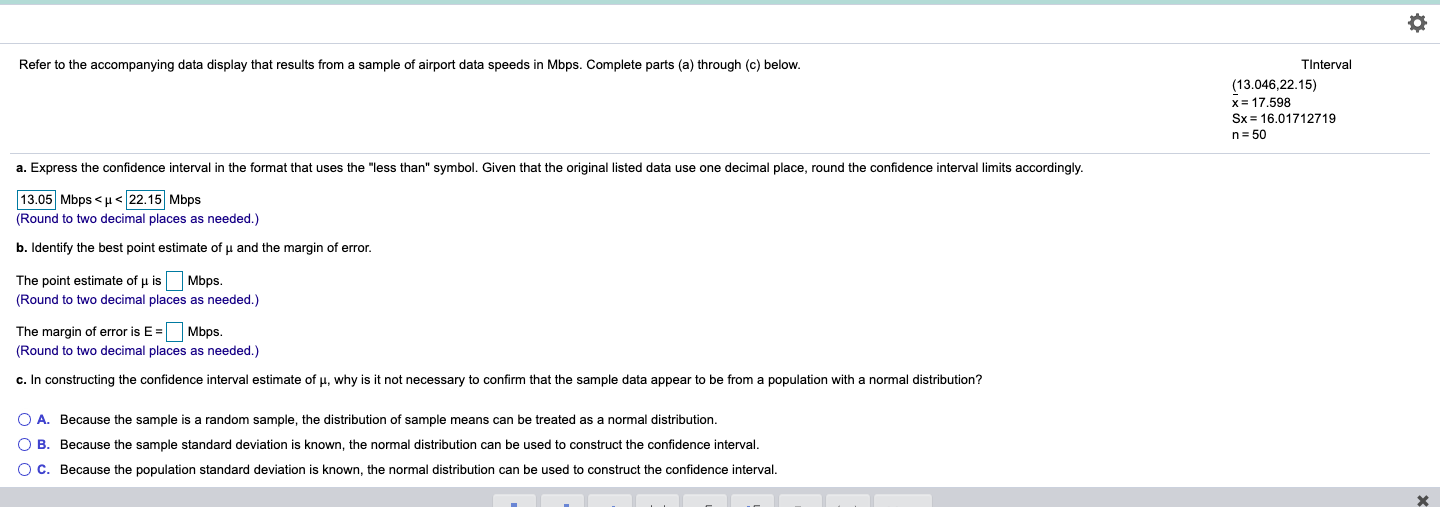Refer to the accompanying data display that results from a sample of airport data speeds in Mbps. Complete parts (a) through (c) below. TInterval (13.046,22.15) X= 17.598 Sx = 16.01712719 n= 50 a. Express the confidence interval in the format that uses the "less than" symbol. Given that the original listed data use one decimal place, round the confidence interval limits accordingly. 13.05 Mbps < u< 22.15 Mbps (Round to two decimal places as needed.) b. Identify the best point estimate of u and the margin of error. The point estimate of u is (Round to two decimal places as needed.) Mbps. The margin of error is E = Mbps. (Round to two decimal places as needed.) c. In constructing the confidence interval estimate of u, why is it not necessary to confirm that the sample data appear to be from a population with a normal distribution? O A. Because the sample is a random sample, the distribution of sample means can be treated as a normal distribution. O B. Because the sample standard deviation OC. Because the population standard deviation is known, the normal distribution can be used to construct the confidence interval. known, the normal distribution can be used to construct the confidence interval.
Refer to the accompanying data display that results from a sample of airport data speeds in Mbps. Complete parts (a) through (c) below. TInterval (13.046,22.15) X= 17.598 Sx = 16.01712719 n= 50 a. Express the confidence interval in the format that uses the "less than" symbol. Given that the original listed data use one decimal place, round the confidence interval limits accordingly. 13.05 Mbps < u< 22.15 Mbps (Round to two decimal places as needed.) b. Identify the best point estimate of u and the margin of error. The point estimate of u is (Round to two decimal places as needed.) Mbps. The margin of error is E = Mbps. (Round to two decimal places as needed.) c. In constructing the confidence interval estimate of u, why is it not necessary to confirm that the sample data appear to be from a population with a normal distribution? O A. Because the sample is a random sample, the distribution of sample means can be treated as a normal distribution. O B. Because the sample standard deviation OC. Because the population standard deviation is known, the normal distribution can be used to construct the confidence interval. known, the normal distribution can be used to construct the confidence interval.
MATLAB: An Introduction with Applications
6th Edition
ISBN:9781119256830
Author:Amos Gilat
Publisher:Amos Gilat
Chapter1: Starting With Matlab
Section: Chapter Questions
Problem 1P
Related questions
Question

Transcribed Image Text:Refer to the accompanying data display that results from a sample of airport data speeds in Mbps. Complete parts (a) through (c) below.
TInterval
(13.046,22.15)
X= 17.598
Sx = 16.01712719
n= 50
a. Express the confidence interval in the format that uses the "less than" symbol. Given that the original listed data use one decimal place, round the confidence interval limits accordingly.
13.05 Mbps < u< 22.15 Mbps
(Round to two decimal places as needed.)
b. Identify the best point estimate of u and the margin of error.
The point estimate of u is
(Round to two decimal places as needed.)
Mbps.
The margin of error is E = Mbps.
(Round to two decimal places as needed.)
c. In constructing the confidence interval estimate of u, why is it not necessary to confirm that the sample data appear to be from a population with a normal distribution?
O A. Because the sample is a random sample, the distribution of sample means can be treated as a normal distribution.
O B. Because the sample standard deviation
OC. Because the population standard deviation is known, the normal distribution can be used to construct the confidence interval.
known, the normal distribution can be used to construct the confidence interval.
Expert Solution
This question has been solved!
Explore an expertly crafted, step-by-step solution for a thorough understanding of key concepts.
This is a popular solution!
Trending now
This is a popular solution!
Step by step
Solved in 3 steps with 4 images

Recommended textbooks for you

MATLAB: An Introduction with Applications
Statistics
ISBN:
9781119256830
Author:
Amos Gilat
Publisher:
John Wiley & Sons Inc

Probability and Statistics for Engineering and th…
Statistics
ISBN:
9781305251809
Author:
Jay L. Devore
Publisher:
Cengage Learning

Statistics for The Behavioral Sciences (MindTap C…
Statistics
ISBN:
9781305504912
Author:
Frederick J Gravetter, Larry B. Wallnau
Publisher:
Cengage Learning

MATLAB: An Introduction with Applications
Statistics
ISBN:
9781119256830
Author:
Amos Gilat
Publisher:
John Wiley & Sons Inc

Probability and Statistics for Engineering and th…
Statistics
ISBN:
9781305251809
Author:
Jay L. Devore
Publisher:
Cengage Learning

Statistics for The Behavioral Sciences (MindTap C…
Statistics
ISBN:
9781305504912
Author:
Frederick J Gravetter, Larry B. Wallnau
Publisher:
Cengage Learning

Elementary Statistics: Picturing the World (7th E…
Statistics
ISBN:
9780134683416
Author:
Ron Larson, Betsy Farber
Publisher:
PEARSON

The Basic Practice of Statistics
Statistics
ISBN:
9781319042578
Author:
David S. Moore, William I. Notz, Michael A. Fligner
Publisher:
W. H. Freeman

Introduction to the Practice of Statistics
Statistics
ISBN:
9781319013387
Author:
David S. Moore, George P. McCabe, Bruce A. Craig
Publisher:
W. H. Freeman